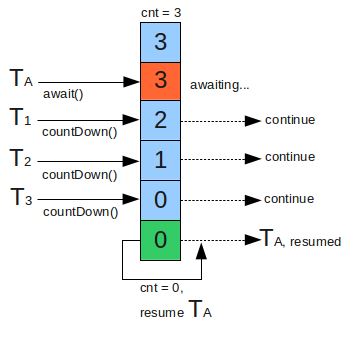介绍
同步辅助类
CountDownLatch类位于java.util.concurrent包下,是在jdk5中引入的一个同步辅助类,它允许一个或多个线程去等待其他线程完成一系列操作。
实现原理
CountDownLatch是通过计数器的方式来实现。首先通过CountDownLatch的构造方法给定计数器的初始值,每当在一个线程中调用一次countDown方法,计数器将减去1;CountDownLatch的await方法是会阻塞,直到计数器减至0时await方法则立刻返回。
注意:这个计数器是不能重置的,如果要重置,则需要使用CyclicBarrier类。

CountDownLatch主要方法
1.构造函数
通过传入一个数值(count)来创建一个CountDownLatch,数值表示线程可以从等待状态恢复,countDown方法必须被调用的次数。
1 | /** |
2.countDown方法
当count本来就为0,此方法不做任何操作,当count比0大,调用此方法进行减1。
1 | /** |
3.await方法
1.不带参数
当count比0大,线程会一直等待,直到count的值变为0,或者线程被中断(interepted,此时会抛出中断异常)。
1 | public void await() throws InterruptedException { |
2.带参数
当count比0大,线程会等待一段时间,等待时间内如果count的值变为0,返回true;当超出等待时间,返回false;或者等待时间内线程被中断,此时会抛出中断异常。
1 | public boolean await(long timeout, TimeUnit unit) |
应用举例
典型用法1
一个典型应用场景就是启动一个任务时,主线程需要等待多个任务都执行完毕,之后再继续执行后续业务。比如现在需要给1000个手机号发送短信,我把发送短信的任务提交到一个线程池中,等线程池中的发送任务都执行完后,最后再关闭线程池。再比如批量取消订单、批量上传文件等等都是类似的场景。
具体做法是,将CountDownLatch的计数器初始化为new CountDownLatch(n),每当一个任务线程执行完毕,就将计数器减1 countdownlatch.countDown(),当计数器的值变为0时,在CountDownLatch上 await() 的线程就会被唤醒。
例如需要给1000个手机号发送短信消息,通常可以使用多线程的方式,使用CountDownLatch可以确保给所有手机号都发送了短信,具体做法示例:1
2
3
4
5
6
7
8
9
10
11
12
13
14
15
16
17
18
19
20
21
22
23
24
25
26
27
28
29
30
31
32
33
34
35
36
37
38
39
40
41
42
43
44
45
46
47
48
49
50
51
52
53
54package com.lzumetal.multithread.counter;
import java.util.ArrayList;
import java.util.List;
import java.util.Random;
import java.util.concurrent.*;
/**
* @author liaosi
* @date 2018-09-27
*/
public class CountDownTest1 {
public static void main(String[] args) {
List<String> mobiles = new ArrayList<>();
for (int i = 0; i < 1000; i++) {
mobiles.add(StringUtil.getMobile());
}
ExecutorService threadPool = new ThreadPoolExecutor(2, 10,
3000, TimeUnit.SECONDS, new LinkedBlockingDeque<>());
CountDownLatch countDownLatch = new CountDownLatch(mobiles.size());
try {
for (String mobile : mobiles) {
threadPool.submit(() -> {
try {
} catch (Exception e) {
sleep();
System.out.println(Thread.currentThread().getName() + "发送短信。。。" + mobile);
} finally {
countDownLatch.countDown();
}
});
}
countDownLatch.await();
System.out.println("===========已全部添加到线程池===========");
} catch (InterruptedException e) {
e.printStackTrace();
} finally {
threadPool.shutdown();
}
}
public static void sleep() {
try {
TimeUnit.MILLISECONDS.sleep(new Random().nextInt(500));
} catch (InterruptedException e) {
e.printStackTrace();
}
}
}
典型用法2
另一个个典型用法是:实现多个线程开始执行任务的最大并行性。注意是并行性,不是并发,强调的是多个线程在某一时刻同时开始执行。类似于赛跑,将多个线程放到起点,等待发令枪响,然后同时开跑。
做法是初始化一个共享的CountDownLatch(1),将其计数器初始化为1,多个线程在开始执行任务前首先 coundownlatch.await(),当主线程调用 countDown() 时,计数器变为0,多个线程同时被唤醒。
1 | package com.lzumetal.multithread.counter; |
注:仔细分析,上面的起跑应该并不是严格意义上的同时刻并行的。因为虽然线程池的线程数量和任务数量是一样的,这样每一个线程会去执行一个任务,但考虑到cpu的核心数是未知的,并且结合cpu的分片原理,并不能确保5个线程在同一时刻开始执行任务。